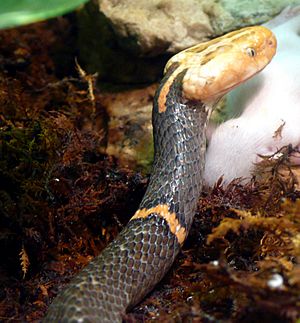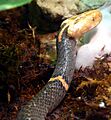Azemiops facts for kids
Quick facts for kids Azemiops |
|
|---|---|
 |
|
| Conservation status | |
| Scientific classification |
|
| Kingdom: | Animalia |
| Phylum: | Chordata |
| Class: | Reptilia |
| Order: | Squamata |
| Suborder: | Serpentes |
| Family: | Viperidae |
| Subfamily: | Azemiopinae Liem, Marx & Rabb, 1971 |
| Genus: | Azemiops Boulenger, 1888 |
| Species | |
|
|
The Azemiopinae is a special group of snakes. It contains only one genus called Azemiops. This genus includes two types of viper snakes: A. feae and A. kharini. People often call them Fea's vipers. There are no smaller groups (subspecies) recognized for them.
An Italian explorer named Leonardo Fea found the first one. A scientist named Boulenger described it in 1888. For a long time, scientists thought these were the oldest type of vipers. But new studies show they are closely related to pit vipers. You can find these snakes in the mountains of Southeast Asia. They live in China, southeastern Tibet, and Vietnam. Like all other vipers, they are venomous.
Contents
Meet Fea's Vipers: Appearance
These snakes are not very long. Neither species grows to be 1 meter (about 3 feet) in length. The longest one ever recorded was about 78 centimeters (30 inches) long.
Fea's vipers are unique among vipers. Most vipers have rough, keeled scales. But Fea's vipers have smooth scales. Their heads are also different. Most vipers have many small scales on their heads. Fea's vipers have large, shield-like scales. These are more like the scales found on colubrid or elapid snakes.
They do have hollow, movable fangs, but these fangs are short. Their venom glands are also quite small. Unlike most vipers, Fea's vipers lay eggs. This is called being oviparous. They also sleep through the winter, which is called hibernating.
Colors and Patterns
Fea's vipers have striking colors. Their body color is a shiny, deep blue-gray or black. They have thin, white-orange stripes across their backs. These stripes are spaced far apart. Their heads are orange or slightly yellow. They have a clear gray pattern on their heads. Their eyes are yellowish with pupils that look like slits. Their bellies are olive-gray with some lighter spots. Their chin and throat have yellow markings.
Where Fea's Vipers Live
These snakes live in northern Vietnam. They also live across southern China. This includes areas like Fujian and Yunnan. You can also find them in southeast Myanmar and southeast Tibet. The two different species are separated by the Red River. A. kharini lives to the east of the river. A. feae lives to the west.
Fea's Viper Habitat
Fea's vipers live in mountain areas. They can be found at heights up to 1,000 meters (about 3,300 feet). They like cooler places, usually around 20-25°C (68-77°F). Sometimes, people see them on roadsides. They can also be found in straw, grass, or rice fields. They might even be found in and around homes.
In Vietnam, they prefer forests with bamboo and tree ferns. These forests often have open areas. The ground is covered with rotting plants. There are also many rocks and streams, some above ground and some underground. These snakes are most active at dawn and dusk. They like very moist places to hide.
How Fea's Vipers Behave
Fea's vipers have a special way to show they are upset. When bothered, they flatten their bodies. This makes them look wider. Their jaws also spread out, making their head look like a triangle instead of its usual oval shape. Sometimes, they shake their tails. If they feel very threatened, they will strike. They may or may not use their fangs when they strike. Some reports say they are active at dawn and dusk. Others say they are active at night. They are usually active from early March to late November.
What Fea's Vipers Eat
These snakes seem to eat small mammals. One young snake was found to have eaten a common gray shrew. When kept in captivity, these snakes do not like to eat much. But when they do eat, they prefer newborn mice. They only eat at night. When they were seen eating, they held onto their prey after striking it.
Fea's Viper Venom
The venom of Fea's viper is interesting. It is quite similar to the venom of another snake, Wagler's viper. One study found that Fea's viper venom has enzymes like other viper venoms. However, its venom does not cause blood to clot. It also does not cause bleeding or muscle damage. One special toxin in their venom is called azemiopsin. This toxin can block certain signals in muscles.
Images for kids
See also
 In Spanish: Azemiops para niños
In Spanish: Azemiops para niños



